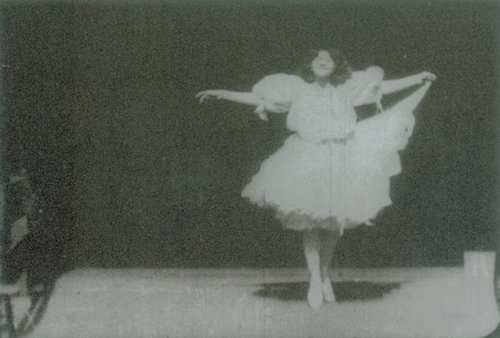Moving Pictures
dal 12/9/2006 al 8/12/2006
Segnalato da
George Bellows
Thomas Eakins
Childe Hassam
Maurice Prendergast
William Merritt Chase
George Luks
John Singer Sargent
Nancy Mowll Mathews
Eugenie Prendergast
12/9/2006
Moving Pictures
Grey Art Gallery, New York
American Art and Early Film, 1880-1910

American Art and Early Film, 1880-1910
New technologies often inspire artistic innovation. Moving Pictures: American Art and Early Film, 1880-1910 explores the links—both deliberate and coincidental—between the earliest movies and other American visual art forms at the beginning of the 20th century. The first exhibition to integrate cinema into a history of American art, Moving Pictures features approximately 100 artworks and 50 films. In this landmark exhibition, which will be on view at New York University’s Grey Art Gallery from September 13 through December 9, 2006, paintings by American masters such as George Bellows, Thomas Eakins, Childe Hassam, Maurice Prendergast, William Merritt Chase, George Luks, and John Singer Sargent are installed alongside films—which were first shown commercially in 1895. These provocative juxtapositions reveal how the radically new technological advances in moving pictures impacted perception, visual representation, and definitions of reality. The films—consisting mostly of short, one-to-two minutes of “real life" footage—derive primarily from the Edison, Lumie're, and American Mutoscope and Biograph companies, and are lent by the Library of Congress. The exhibition thus enriches our understanding of both early cinema and older fine arts media such as painting, drawing, and printmaking.
Moving Pictures was organized by the Williams College Museum of Art and curated by Nancy Mowll Mathews, Euge'nie Prendergast Senior Curator of 19th and 20th Century Art. The exhibition has a two-fold mission. It initially looks at the ways early filmmakers employed 19th-century aesthetic traditions—from landscape to portraiture—to develop this new art form. The show then explores how the new medium of film impacted visual artists at the beginning of the 20th century, revealing, for example, that Ashcan
School artists depicted the city like a series of film sets. “To investigate these two great artistic enterprises—fine arts and motion pictures—at the moment when the new medium of film emerged is tremendously exciting," observes Mathews. “Both paintings and films emphasize movement, which was crucial to the illusion of lifelikeness in both media. In recreating the modern experience of fragmentation and spectacle, both art and film explore issues of human perception and understanding of reality that were part of the intellectual climate of their day." To achieve greater veracity, artists also eagerly studied the experiments of motion photographers Eadweard Muybridge and Etienne-Jules Marey, initiating an exchange between photographers and painters. In the 1890s, technology was perfected to animate these photographs. The resulting early films naturally echoed established currents in American art. By 1900, however, the influences flowed both ways and American painting echoed the new view of the world offered by moving pictures.
“We are very pleased to collaborate with the Williams College Museum of Art in providing a New York venue for this innovative show which rewrites the history of American art," notes Lynn Gumpert, director of the Grey Art Gallery. “Part of our mandate as a university museum is to serve as a laboratory, with an emphasis on experimentation, reassessment, and interpretation. And of course, NYU’s Tisch School of the Arts is at the forefront of teaching cinema, providing a fantastic opportunity to engage students and faculty along with other New York audiences." Until recently, an exhibition like Moving Pictures would have been a technological nightmare. But with the advent of flat-screen monitors and DVD players, early film clips can be shown side-by-side with artworks, providing illuminating insights into how the world was represented and perceived in the early 20th century.
Moving Pictures is presented in four components: the introductory section suggests parallels between the first American films and traditional artistic genres such as landscape and marine painting. The second section examines the rise of motion photography and its influence on depictions of the human figure in art and film in the 1890s. The third demonstrates the post-1900 shift in painterly and filmic depictions of urban life: from Impressionist visions to gritty American realist images. The concluding section explores the mutual fascination between practitioners of the fine arts and film in the early days of the new medium. Along with paintings and movies, the exhibition includes posters, early views of kinetoscope parlors, and films about art and artists, photographers, and filmmaking. Highlighting the multifaceted interrelationships between film and other visual art forms, Moving Pictures offers a groundbreaking reinterpretation of a crucial period in modern American visual culture.
After closing at the Grey Art Gallery, the show travels to the Phillips Collection in Washington, DC, where it will be on view from February 17 through May 20, 2007. Moving Pictures is accompanied by a lavishly illustrated catalogue, published by Hudson Hills Press, with a DVD featuring the films. Essays by thirteen leading art and film historians focus on the intriguing and complex interrelationships between still and moving pictures.
This exhibition was funded in part by The Henry Luce Foundation, the Euge'nie Prendergast Trust, the National Endowment for the Arts, the Williams College Center for Technology in the Arts & Humanities (CTAH), H.H. Powers Fund, and the Orrin Simons Fund. The presentation at the Grey Art Gallery is made possible by the Abby Weed Grey Trust. Public programs are funded by the Grey’s Inter/National Council.
Image: Edison Manufacturing Company, Amy Muller, 1896 (film still). Producer and camera: William Heise. The Library of Congress, Washington, D.C., Motion Picture, Broadcasting, and Recorded Sound Division, Hendricks Collection
Grey Art Gallery, New York University, 100 Washington Square East, New York, NY 10003
Hours:
Tuesday, Thursday, Friday: 11am-6 pm
Open Late Wednesday: 11 am-8 pm
Saturday: 11 am-5 pm
Sunday, Monday and major holidays: Closed
Admission: Suggested donation: $3; NYU staff, faculty, and students: free of charge



